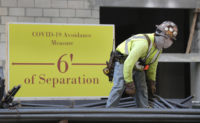Judging from the dismay that apparently helped convince the U.S. Occupational Safety and Health Administration to change its guidelines for employer-required COVID-19 vaccines—unlike the original guidelines, the latest revision won’t require employers to record adverse reactions in OSHA logs—the industry should keep a sharp eye out for what’s still to come from the agency. A planned new COVID-19 safety standard may cause even more vexing complications. The Associated General Contractors and other groups ask that OSHA “align its protocols” with those issued by the Centers for Disease Control and Prevention. The often-revised CDC guidelines have generated a fair amount of confusion as understanding evolves of virus transmission and the effects of vaccines. Keeping OSHA and CDC on the same page benefits everyone.
But COVID-19-related record-keeping issues still may turn out to be critical. A coalition of employers, through a comment paper prepared by the group’s attorney, has asked for a separate record for virus-related events and illnesses. In other words, OSHA would exempt COVID-19 from OSHA Standard 1904: Injury and Illness Recordkeeping, and place virus entries in a different history or list.
The idea is based partly on reports of employer difficulties—and long hours spent— in determining whether COVID-19 cases among employees are work-related and therefore belong in employer OSHA 300 logs. This separate-record approach would not prevent inspection. The COVID-19 cases would be kept confidential but made available to employees or their representatives with personal identity information scrubbed. No party other than OSHA and local or regional health officials would have access to the separate record.
Under California’s emergency temporary COVID-19 standard, employers must also contact local health departments when there are three or more virus cases within a 14-day period in the same workplace and give health officials information about the employees. This approach would allow the separate log to be useful in contact tracing.
But having a separate COVID-19 log also would prevent virus cases from instantly altering the overall safety picture of an employer’s project or workplace. This is especially true because, as we know, the spread of COVID-19 and its causes may not reflect a lapse on the part of an employer. Employers can follow all the various and changing rules to prevent transmission, yet the virus still can be carried into the workplace.
With vaccination proving successful and COVID-19 science providing new insights, we look forward to the eventual sunset of the temporary emergency standard and a fresh understanding of how to deal with this public health crisis—although unfortunately it will be achieved amid a continuing tragedy that has included 588,000 U.S. deaths so far.





